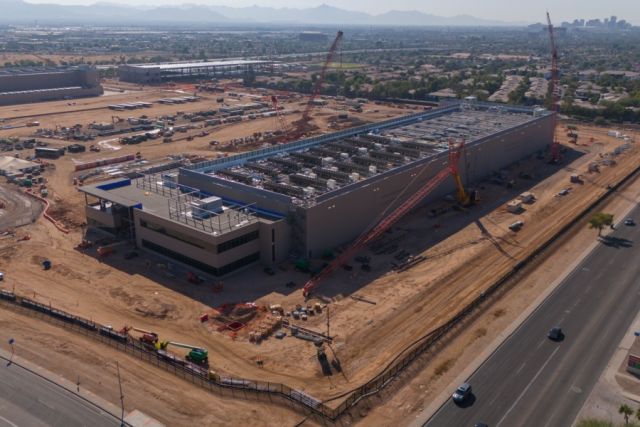
An aerial view of a center under construction in Phoenix, Arizona. (Source: Shutterstock.com)
Houston-based LandBridge Co., which IPO’d on June 28 on the New York Stock Exchange as LB, has a land-lease agreement with a data center developer in the Delaware Basin with construction potentially beginning in two years.
That and other electron-hungry data centers may take up to 2 Bcf/d off Permian Basin oil producers’ hands, according to David Capobianco, chairman of LandBridge.

Hart Energy caught up with Capobianco on the NYSE floor in the morning before the stock began trading. The 14.5 million pre-IPO shares were sold June 27 at $17. The stock opened June 28 at $19.48 and was trading at $21.59 in light volume at press time.
The company owns 220,000 contiguous Delaware Basin acres along the Texas-New Mexico border.
Capobianco is the founder of private-equity firm Five Point Energy, the lead owner of LandBridge and its sister company, Permian water-handling operator WaterBridge. Prior, he was a founder and co-head of late Microsoft Corp. co-founder Paul Allen’s Vulcan Capital.
Nissa Darbonne, executive editor-at-large, Hart Energy: What are plans for the IPO proceeds?
David Capobianco, chairman, LandBridge: Proceeds will strengthen the balance sheet and to pay a distribution to the founding investors.
ND: Does that mean paying off debt?
DC: That's a safe assumption. It's a low leverage ratio. We're going to come out in the high 2.0x and we'll bring that down over the next 12 months to around 2.0x debt to EBITDA.
So it is a very low leverage strategy, but we'll continue to pay down debt.
We'll pay a modest dividend: 2% to 2.5%. And as we pay down debt, we will be building liquidity to ultimately consider either raising the dividend or executing highly accretive transactions.
ND: Outside of O&M (operation and maintenance), is LandBridge essentially just printing money?
DC: It is, yes. We have a 90% EBITDA margin and a high [end of] 70% free cash flow margin.
ND: You’re looking to add acreage?
DC: Absolutely. We will look at opportunities [where] we can make better with our own infrastructure from sister companies to develop them. And if we have a superior advantage in that regard, we will buy it.
ND: Will the additional acreage be for water handling or other use?
DC: WaterBridge only makes up about 17% of LandBridge revenues. The beauty of WaterBridge, though, is we know how much infrastructure will be developed. We know how much water will be moved and that enables us to have a predictable growth profile at LandBridge.
But we manage our land for infrastructure builders—and that's infrastructure across the spectrum. That's water, energy, pipelines, gas plants, sand mines. We have an incredible sand trend that goes through our acreage.
Then you have renewable power infrastructure—solar and wind.
And then the last piece, which will be an important part of the future also, is data-center development: The digital infrastructure that will be developed in West Texas on contiguous pieces of land.
ND: To power that, are y'all talking to any small modular [nuclear] reactor companies like Oklo [Inc.]?
DC: Small modular reactors are the future of data centers, [but] we look at that as a decade or so out. The need is today; it is imminent. We need to build five to seven times as much data-center capacity than has been built in our history.
And to do that, we're going to need to focus on places with low-cost fuel. In the Permian, where you have $0 to negative-$7 gas.
It’s pretty attractive. And you have an incredible regulatory environment.
We, because of our sister company [WaterBridge], have unlimited water for cooling.
We have very good fiber. Not the kind of fiber hub you have around Langley, Virginia, where 61% of worldwide data centers are. But we have very good fiber through our surface. And over time that will improve.
Over time, the connectivity between the data centers developed in the Permian Basin will also turn it into a fiber hub.
ND: Are y'all already talking to some data-center developers?
DC: We are. At Five Point, we’ve created a partnership with a developer with the goal of building out a 1-gigawatt data center on our surface.
To add to that, building out a 1-gigawatt data center will be driven by a 250-megawatt solar farm that we have on the same contiguous acreage and a gigawatt power plant.
ND: Data centers seem very appropriate for West Texas for lots of reasons, but among them they don’t require many people on the ground to support operations versus, say, a chip manufacturer.
DC: It's more of a management/monitoring program.
But you appropriately recognize that there aren’t many people who live out there. But we also expect that, over time, all the development that I'm talking about will develop West Texas as well. And I'm talking about modular condominiums, restaurants, places for people to live—more than just the man-camp program that we have today.
ND: Eagle Ford, Barnett and Haynesville gas producers will be glad to see more Permian gas get used in-basin and not sent to the Gulf Coast. How quickly might the data centers come online?
DC: Construction would begin in two years. Operations could be possible in four years. We've signed a 100-year lease agreement.
ND: Can you reveal who is the data center operator?
DC: I'll be making a press release about that in the next few months.
ND: Some use for that gas will be appreciated out there.
DC: Well, it's stranded and more than that, [using it in-basin] will massively change the economics of the Permian.
To put it into context, a gigawatt data center may take about 300 MMcf/d. We have six locations for data centers. You're talking about almost 2 Bcf of in-basin gas need. It would dramatically change the dynamics of prices at Waha.
ND: How is LandBridge different than the Permian Basin’s Texas Pacific Land (TPL)?
DC: I would make a couple distinctions. First, TPL has 880,000 acres spread out through the whole Permian. Some of those acres are in the core and some of those acres are in the dirt-farm category.
Also, because of the way TPL came together [from 19th century railroad land grants], much of their acreage is checkerboarded with other owners. And if you don't get the approval and the agreement with the other owners, it's very difficult to develop.
Our 220,000 acres are uniquely positioned at the Texas-New Mexico border, and they create an opportunity to manage water that is produced in New Mexico, brought to Texas, recycled and returned to New Mexico.
ND: And the minerals that came with the railroad land grants?
DC: Oil and gas mineral royalties are a major part of TPL’s revenue stream—57% compared to 17% of ours. We look at [minerals] as our least attractive part of our revenue stream: It is the only part of our revenue stream that's depleting.
ND: While oil wells are a depleting asset, they make more business for WaterBridge, as Delaware Basin wells’ water production grows as they age, yes?
DC: So right now in the Delaware, we're about 4:1 water/oil ratio in the wells. As those wells age, yes, you do have a slightly higher [percentage] of water.
But even more important than that, some of the newer zones—the deeper zones—have higher water ratios: 5:1 and 6:1 and even 7:1.
So yes, I would anticipate that the Delaware Basin’s water/oil ratio will rise over time.
But the long-term opportunity is that New Mexico alone will grow its water production between 750,000 and 1 bbl/d per year. That means over the next three to five years, there'll be 3 to 5 million more bbl/d of water produced in New Mexico.
Some of that will be recycled. The lion's share of that water will move to Texas, south and east.
And because of our contiguous location across the state line, it will likely either come to our ranch for management or come through to our ranch. That 3 [MMbbl/d] to 5 MMbbl/d creates a $200- to $300 million annual free cash flow opportunity for the ranch.
ND: Is crypto-mining still much of a thing these days in West Texas? Any on LandBridge’s property?
DC: We're fine for [having] crypto-mines too. We have a Bitcoin mine on our acreage. We get a terrific rent and they annually use a substantial amount of water for their cooling.
So they're great surface-users as well. That Bitcoin and crypto infrastructure will absolutely be developed in West Texas.
That's not the big story though. The big story is data centers.
Recommended Reading
TG Natural Resources Wins Chevron’s Haynesville Assets for $525MM
2025-04-01 - Marketed by Chevron Corp. for more than a year, the 71,000-contiguous-net-undeveloped-acreage sold to TG Natural Resources is valued by the supermajor at $1.2 billion at current Henry Hub futures.
Sempra Plans to Sell Assets, LNG Stakes to Invest in Utilities
2025-03-31 - Infrastructure company Sempra Energy is preparing for major growth coming in electrical demand by selling assets to raise capital.
GeoPark Divests Non-Core Colombia, Brazil Assets, Cuts Workforce
2025-03-31 - GeoPark is selling non-core assets and reducing its headcount, the Colombia-based oil and gas firm said March 31.
Japan's Tokyo Gas to Buy Stake in Texas Shale from Chevron
2025-03-31 - The deal estimated to be worth tens of billions of yen, the Nikkei reported on March 31.
BlackRock’s Fink Calls for Reliable US Power Grid—Now
2025-03-31 - “That starts with fixing the slow, broken permitting processes in the U.S. and Europe,” Larry Fink, the co-founder, chairman and CEO of $12 trillion investment-management firm BlackRock Inc., told shareholders March 31.
Comments
Add new comment
This conversation is moderated according to Hart Energy community rules. Please read the rules before joining the discussion. If you’re experiencing any technical problems, please contact our customer care team.





